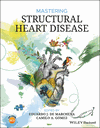Ventricular Septal Defects Closure
Jose Luis Zunzunegui
1 Gregorio Marañon Hospital, Madrid, Spain
Search for more papers by this authorJose Luis Zunzunegui
1 Gregorio Marañon Hospital, Madrid, Spain
Search for more papers by this authorEduardo J. de Marchena
International Medicine Institue, Miami, FL, United States
Search for more papers by this authorSummary
Ventricular septal defects (VSDs) are the most common congenital heart disease (20% of cases). Muscular VSDs (MVSDs) account for 20% of interventricular septum defects, being the most common location in the apical portion of the muscular septum, followed by the mid-ventricular and the anterior in the right outflow tract. Many of these muscular defects can be closed percutaneously with self-expanding devices adapted to the ventricular anatomy. On the other hand, perimembranous VSDs (PMVSDs) are the most frequent, and although the proximity of the aortic valve makes them a challenge, the development of new devices has made percutaneous closure possible. In this chapter, we will review the devices used in this therapy, implant techniques, and possible complications, distinguishing the approach for MVSD and PMVSD.
Bibliography
- Carminati , M. , Butera , G. , Chessa , M. et al. ( 2007 ). Investigators of the European VSD registry transcatheter closure of congenital ventricular septal defects: results of the European registry . Eur. Heart J. 28 ( 19 ): 2361 – 2368 .
- Esmaeili , A. , Behnke-Hall , K. , Schrewe , R. , and Schranz , D. ( 2019 ). Percutaneous closure of perimembranous ventricular septal defects utilizing almost ideal Amplatzer duct Occluder II: why limitation in sizes? Congenit. Heart Dis. 14 ( 3 ): 389 – 395 .
- Haas , N.A. , Kock , L. , and Bertram , H. ( 2017 ). Interventional VSD-closure with the Nit-Occlud () Le VSD-Coil in 110 patients: Early and midterm results of the EUREVECO-Registry . Pediatr. Cardiol. 38 ( 2 ): 215 – 227 .
- Nguyen , H.L. , Phan , Q.T. , Dinh , L.H. et al. ( 2018 ). Nit-Occlud Lê VSD coil versus Duct Occluders for percutaneous perimembranous ventricular septal defect closure . Congenit. Heart Dis. 13 ( 4 ): 584 – 593 .
- Nguyen , H.L. , Phan , Q.T. , Doan , D.D. et al. ( 2018 ). Percutaneous closure of perimembranous ventricular septal defect using patent ductus arteriosus occluders . PLoS One 13 ( 11 ): e0206535 .
- Quereshi , S. and Carminati , M. ( 2014 ). Cardiac Catheterization for Congenital Heart Diseases; from Fetal Life to Adulthood , 1 e. Milan, Heildelberg, New York, Dordrecht, London : Springer .
- Quereshi , S. and Carminati , M. ( 2014 ). Cardiac Catheterization for Congenital Heart Diseases; from Fetal Life to Adulthood , 1 e. Milan, Heildelberg, New York, Dordrecht, London : Springer .
- Rigatelli , G. , Zuin , M. , and Nghia , N.T. ( 2018 ). Interatrial shunts; technical approaches to percutaneous closure . Expert. Rev. Med. Devices 707 – 716 .
- Silversides , C.K. , Dore , A. , Poirier , N. et al. ( 2010 ). Canadian cardiovascular society 2009 consensus conference on the management of adults with congenital heart disease: shunt lesions . Can. J. Cardiol. 26 : E70 – E79 .
- Solana-Gracia , R. , Mendoza Soto , A. , Carrasco Moreno , J.I. et al. ( 2021 ). Spanish registry of percutaneous VSD closure with NitOcclud Le VSD coil device: lessons learned after more than a hundred implants . Rev. Esp. Cardiol. (Engl. Ed.) 74 ( 7 ): 591 – 601 .
- Walavalkar , V. , Maiya , S. , Pujar , S. et al. ( 2020 ). Percutaneous device closure of congenital isolated ventricular septal defects; a single-center retrospective database study amongst 412 cases . Pediatr. Cardiol. 41 ( 3 ): 591 – 598 .
- Warnes , C.A. , Williams , R.G. , Bashore , T.M. et al. ( 2008 ). ACC/ AHA 2008 guidelines for the management of adults with congenital heart disease: a report of the American College of Cardiology/American Heart Association task force on practice guidelines (writing committee to develop guidelines on the management of adults with congenital heart disease). Developed in collaboration with the American Society of Echocardiography, Heart Rhythm Society, and International Society for Adult Congenital Heart Disease, Society for Cardiovascular Angiography and Interventions, and Society of Thoracic Surgeons . J. Am. Coll. Cardiol. 52 : E143 – E263 .



